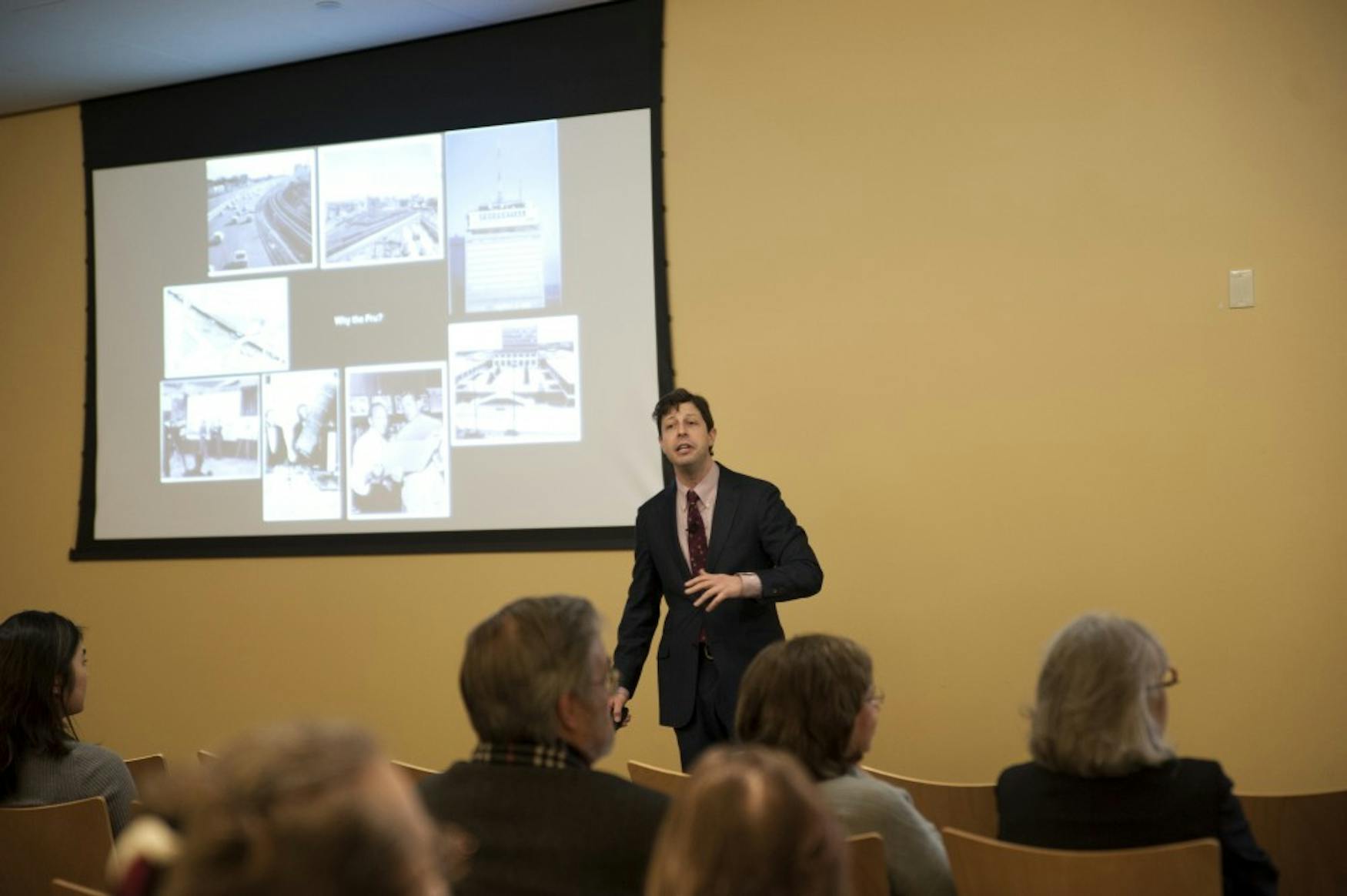Speaker discusses the Pru’s modern relevance
Taking his audience back in time to a fascinating period of urban redevelopment, Elihu Rubin told the story of the Prudential Center, a Boston landmark which offers insight into the birth of its modern post-industrial city. Rubin gave his talk on Thursday night, Feb. 15.
Rubin, a professor of urbanism at the Yale School of Architecture, began his lecture with a surprising admission: He collects postcards with images of insurance company headquarters on them. Rubin showed the audience snapshots of his collection, featuring diverse and intriguing architectural constructions, before stopping on an image of a tall rectangular tower with the word “Prudential” written across the top.
Rubin himself admitted of the Prudential Center in Boston: “No one ever thought that the building was all that … great.” For Rubin, however, as he studied this initially boring building, it became “a kind of prism” that revealed “important trends and ideas in postwar American urbanism.”
‘The Pru,’ as Rubin referred to the building, was designed by Charles Luckman and William Pereira in the early 1960s as an office for the life insurance company Prudential Financial Inc. Located in midtown Boston, the Pru is a massive tower surrounded by an open plaza filled with shops. According to Rubin, Luckman’s goal was to “humanate” the city by creating “massive concourses and plazas” to bring “lots of light and air into the urban core.”
The story of the Pru is far more complicated than breathing room in the city, however, and can give insight into the major role insurance companies played in urban development in the 1950s and 1960s. Just as railroads helped shape urban landscapes in the 19th century, Rubin argues that insurance companies were “one of the motive forces of urban change, architecture and urban development in the 20th century.”
“You can’t tell the story of American architectural history without considering buildings which have been produced by insurance companies,” Rubin said. He pointed to the major financial investments that insurance companies made after World War II to redevelop industrial cities. During this time period, insurance companies stepped in to invest in the cities, transforming them into post-industrial landscapes.
The Pru’s construction was part of a national decentralization of the Prudential company, in a response to the company’s massive growth. In the 1950s and 1960s, the company created offices in cities across the country, such as Los Angeles and Houston. Prudential developed its approach to urban architecture prior to building the Pru, choosing larger areas of land outside the crowded downtown to have both the iconic Prudential tower as well as parking and amenities, according to Rubin.
“They want the tower with ‘Pru,’ but they want to control a big chunk of land,” Rubin said. With offices like the Pru, Prudential found ways of “navigating this immediate postwar age, where we’re not sure where corporations should locate. Prudential, by locating itself in Boston’s midtown district, was able to “have it both ways,” according to Rubin.
The Pru followed this trend, but unfortunately, the result of Luckman’s “humanating” endeavor was “awkward,” as Rubin put it. Unexpected wind patterns in the plazas made opening doors extremely difficult, and the shopping centers in the Pru were never successful.
The Pru was deeply unpopular in the city. Beginning in the 1990s, the company completely rearranged the plaza’s design to try to solve the problems, Rubin said.
However, the Pru was not a failure in its mission to help develop the city of Boston. Prudential’s pressuring Boston legislators for tax incentives before building the Pru led to a “rewriting of urban redevelopment law,” according to Rubin. This helped change the reputation of Boston as a financially undesirable city to invest in, opening doors for other investments.
Rubin said, “Prudential’s investment helped spark confidence in the city,” going on to call that confidence the “important intangible aspect of urban redevelopment.” Office buildings were constructed in downtown and midtown, part of a “building program” the Pru inspired.
Concluding his lecture, Rubin highlighted the “ironical resilience” of the Pru. “There was nothing sacred about it,” Rubin said. “It was just open enough to allow it to adapt, … and so the Pru makes itself relevant again.”
Juxtaposing the Pru with the new forest of tall, glass buildings in Boston, Rubin said, “Isn’t there something kind of charming, … kind of ‘ugly duckling’ about our little Pru?” He went on to ask, “Isn’t the Pru now so much more of Boston’s character than some of those new glass buildings?”
This event was part of the Richard Saivetz ’69 Annual Memorial Architectural Lecture Series.



Please note All comments are eligible for publication in The Justice.